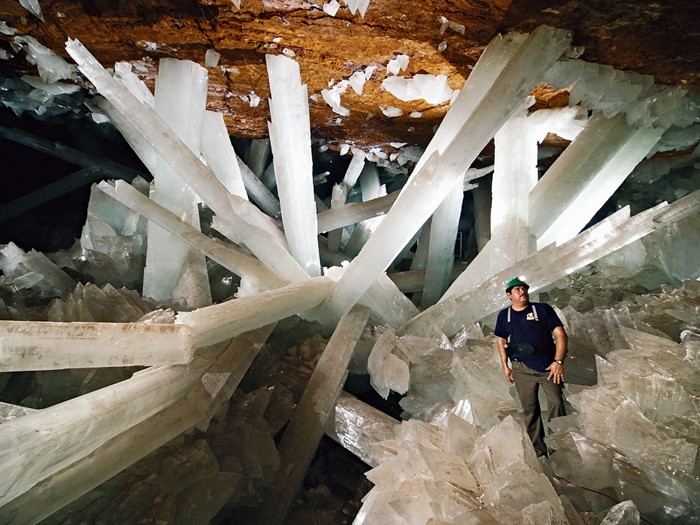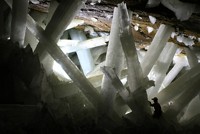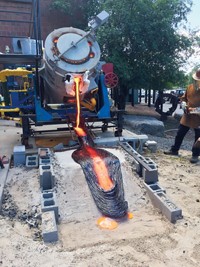Advertisement
Grab your lab coat. Let's get started
Welcome!
Welcome!
Create an account below to get 6 C&EN articles per month, receive newsletters and more - all free.
It seems this is your first time logging in online. Please enter the following information to continue.
As an ACS member you automatically get access to this site. All we need is few more details to create your reading experience.
Not you? Sign in with a different account.
Not you? Sign in with a different account.
ERROR 1
ERROR 1
ERROR 2
ERROR 2
ERROR 2
ERROR 2
ERROR 2
Password and Confirm password must match.
If you have an ACS member number, please enter it here so we can link this account to your membership. (optional)
ERROR 2
ACS values your privacy. By submitting your information, you are gaining access to C&EN and subscribing to our weekly newsletter. We use the information you provide to make your reading experience better, and we will never sell your data to third party members.
Geochemistry
Naica’s crystal cave captivates chemists
Giant gypsum crystals reveal their secrets
by Emma Hiolski, special to C&EN
February 8, 2019
| A version of this story appeared in
Volume 97, Issue 6

Deep below a mountain near Naica, Mexico, miners searching for fresh ore deposits in 2000 came across an unexpected and awesome sight. Massive, milky-white crystals towered around them, filling a horseshoe-shaped cave. Luminous beams of gypsum bigger than telephone poles, nearly 12 m long and 1 m wide, gleamed in the miners’ lights, jutting in all directions out of the brown limestone walls, floors, and ceiling.
The Cave of Crystals, as it became named, is nestled 290 m underground, topped by a mountain rich in lead, zinc, and silver. Since its discovery by the mining company Industrias Peñoles, the subterranean chamber has drawn researchers from around the world, enticing them with both rare beauty and scientific mystery.
Juan Manuel García-Ruiz, a crystallographer at the University of Granada, traveled all the way from Spain to see the crystals for himself. García-Ruiz had grown crystals in laboratory flasks since age 15, so walking among the Naica crystals was, for him, the moment of a lifetime. “When I entered the first time, after the first couple of minutes of stupor, I burst out laughing. I was euphoric,” he says.
In the years since the crystals’ discovery, researchers—including García-Ruiz—have braved the cave’s oppressively hot and humid conditions to answer questions about the crystals’ origin and growth. Now, almost two decades later, having answered many of these questions, scientists are pivoting toward learning how to protect and preserve the crystals for future generations—if the forces at work in the mine and the mountain permit it.
Underground flask
Roughly 26 million years ago, a mound of magma strained upward through the earth beneath southeastern Chihuahua, Mexico. This rising magma created what is now a mountain near the town of Naica and forced hot, mineral-rich waters into caverns and gaps in the mountain’s limestone. It was in these waters that the giant crystals of Naica were born.
The cave was filled with calcium sulfate–rich water. Calcium sulfate can form several minerals, but it turned out that gypsum (CaSO4·2H2O), specifically a transparent, colorless variety known as selenite, came to be the dominant mineral in the caves.

“Each mineral has a stability zone,” explains Alexander Van Driessche, a crystallographer with the National Center for Scientific Research’s Institute of Earth Science, who studied the Naica crystals for his postdoctoral work with García-Ruiz. Anhydrite (CaSO4) becomes more stable above approximately 58 °C; gypsum is the stabler—meaning the less soluble—of the two below that temperature.
Initially, anhydrite deposits formed in the magma-heated waters. Then, over thousands of years, the water gradually cooled. As the temperature crept below 58 °C, anhydrite began to dissolve and gypsum crystals began to nucleate and grow. The dissolving anhydrite supplied the subterranean solution with just enough calcium and sulfate to keep it barely supersaturated, ideal conditions for slowly growing gypsum (Geology 2007, DOI: 10.1130/G23393A.1).
Whether grown in a lab or a cave, all crystals have their humble origins in nucleation, as the crystal’s molecular building blocks arrange themselves around a tiny foundational form and begin to grow. For example, solid particles in our atmosphere serve as nucleators for the ice crystals that eventually drift down to earth as snowflakes. In ionic solutions, high levels of supersaturation promote the nucleation of many crystals, while low levels favor less nucleation but more crystal growth. The Cave of Crystals, therefore, was just right for the few crystals that nucleated to grow to gigantic proportions.
Still marveling at the Naica crystals, Van Driessche and coworkers began to conduct lab studies of gypsum nucleation. The researchers found that gypsum crystals form via an unexpected type of nucleation: they grow from nanoclusters of CaSO4 that coalesce rather than form a tiny starting crystal of gypsum, as researchers would have expected (Science 2012, DOI: 10.1126/science.1215648).
Understanding the fundamentals of how gypsum crystals get their start has implications beyond the caves in Mexico, Van Driessche and García-Ruiz believe. It could help workers combat mineral growth on equipment at desalination plants or help scientists explain how gypsum formed on Mars. But the duo didn’t want to solve just the mystery of the gypsum crystal nucleation. They also wanted to know how Naica’s beams grew to their enormous size.
Infinitesimal growth
The Cave of Crystals is not the only cave under the mountain near Naica filled with gypsum crystals: the same waters that flooded the cave also percolated through other underground chambers nearby. But the crystals in these other chambers did not reach the same mind-blowing size. In addition to the Goldilocks-style conditions that allowed the crystals to form in the first place, a just-right cooling rate allowed them to grow to their mammoth proportions, Van Driessche and García-Ruiz have determined.

The Cave of Swords, at a shallower, 120 m deep location in the mine, illustrates this difference. As its name suggests, its walls are entirely coated in shorter gypsum crystals resembling medieval weaponry up to 2 m long. In the deeper Cave of Crystals, the water cooled at a slower rate than in the Cave of Swords. This incremental cooling over millennia meant that only a few gypsum crystals nucleated, allowing them to grow to a larger size, according to Van Driessche. The temperature dropped faster in the Cave of Swords, forming a greater number of smaller crystals. This is a “textbook example of crystal nucleation and crystal growth,” he says.
Because the water temperature in the Cave of Crystals remained within the transition zone between anhydrite and gypsum for so long, the crystals grew, uninterrupted and undiscovered, for ages. But how long, exactly? The researchers were determined to find out, but finding an answer was not straightforward. The crystals’ high purity meant isotope-dating techniques that rely on traces of elements like uranium could provide only a coarse estimate of their age. Instead, armed with samples of the crystals and water from the Naica mine, Van Driessche, García-Ruiz, and their colleagues set out to painstakingly measure crystal growth rates in the lab.
The gypsum crystal structure—layers of calcium sulfate sandwiching a double layer of water molecules—made this task easier. The hydrogen bonds between the water layers are readily broken, so flakes come off easily from the crystals, providing pure, flat surfaces for growth studies, Van Driessche says.
After placing the pristine gypsum crystal samples in water from the mine for about 24–48 h, the team measured increases in the height of the flat surface using phase-shifting interferometry, a light-based technique that can capture surface growth rates on the order of 10–5 nm/s. By taking measurements at various temperatures, the scientists were able to estimate growth rates for the Naica crystals within the temperature range at which they formed, between about 54 and 58 °C. With this number, they could calculate how long it would have taken a 1 m thick beam to grow at 55 °C.
The answer was astonishing, even knowing that the crystals had to have grown extremely slowly. Such crystals would have taken nearly 1 million years to grow (Proc. Natl. Acad. Sci. U.S.A. 2011, DOI: 10.1073/pnas.1105233108). This is equivalent to adding the thickness of a sheet of paper every 200 years, Van Driessche says.
Drained and dangerous
If the crystals had remained submerged, there’s no telling how much larger they could have grown. Current conditions are still favorable for gypsum crystal formation and growth, with a water temperature at that depth of about 55 °C, Van Driessche says. There are even small ponds in the mine that contain newly formed gypsum crystals, he adds. Over the years of mining activity in Naica, however, the water level has been artificially lowered to provide access to more lead, zinc, and silver deposits. Although draining the cave allowed access to the giant crystals, scientists faced an incredibly harsh environment—one that also posed some risk to the gypsum beams themselves.
While operating the Naica mine, Industrias Peñoles pumped water out of the mountain at a rate roughly equivalent to filling an Olympic-sized swimming pool every 40 min, creating a small, artificial lake near the town of Naica, according to Van Driessche. As the water table dropped, more of the caves and galleries were exposed to air—and humans. The Cave of Crystals, by virtue of its depth and relatively recent discovery, escaped the pillaging that happened in the Cave of Swords, which was discovered in 1910. Collectors took many of the largest and most beautiful crystals in the shallower cave.
Peñoles carefully restricted access to the Cave of Crystals, to protect not only the crystals but also their visitors. Conditions within the cave push human physiology to the limits. The temperature is about 50 °C, with a relative humidity of over 90%: sweating has no cooling effect in that environment.
Walking through the cave is also treacherous, says María Elena Montero-Cabrera, a researcher at the Center for Research in Advanced Materials in Chihuahua. Researchers had to scramble over gypsum spears, slick with condensation, to explore the cave, she says. Everyone had to take great care not to get lost or fall; a rescue operation would be incredibly difficult and dangerous.
Advertisement
Because conditions are so harsh, researchers could stay in the cave for only 10–15 min at a time, Montero-Cabrera says. The cave is sealed off from the rest of the mine by two sets of doors, protecting the crystals from the outside environment and keeping the temperature and humidity in the antechamber tolerable for humans. Before each foray, a medical check was required to ensure that visitors were healthy enough to withstand the cave’s climate, she says.
As intense as these conditions were for the scientists, they posed a different risk to the crystals. The largest beams weigh an estimated 40–50 metric tons, and without the buoying support of water, they run the risk of cracking under their own weight. Gypsum is a very soft mineral—it is considered a 2 on the Mohs scale of hardness, while talc registers a 1 and diamond a 10—so the traffic of human feet has already worn a blackened path into the crystals on the cave floor, Van Driessche says.
To better understand the best way to preserve the crystals for generations to come, Montero-Cabrera and a team of researchers in Chihuahua have examined the effect of the drained environment on the crystal surfaces. In a yearlong laboratory experiment, they subjected samples of the Naica crystals to various gaseous and liquid environments to identify any changes or impurities that could pose a risk to the gypsum’s long-term integrity and appearance.
They found that the crystals fared slightly better in a liquid environment, whereas in gaseous environments they face dehydration. Specifically, they detected bassanite, the dehydrated form of calcium sulfate, on the surface of several of the gypsum crystals (Cryst. Growth Des. 2018, DOI: 10.1021/acs.cgd.8b00583). This indicates that the crystals’ appearance will gradually change with time, but the team’s findings make it clear that removing crystals from the sealed cave is not a viable option for preservation, Montero-Cabrera says.
No crystal ball
Research into the giant crystals of Naica has slowly wound down. Many of the key questions have been answered, and the mining company closed the route to the cave in about 2015, when a leak sprung, letting water into the mine at a rate that outpaced that of the pumps. Though the water level within the mine has risen since, the water doesn’t appear to have reached the Cave of Crystals.

Montero-Cabrera says recent reports from the mine indicate that mining activity will resume through another entrance, potentially allowing researchers to access the cave once more. It remains unclear whether the cave itself will flood again. In the meantime, researchers are heeding the siren call of other alluring gypsum deposits around the world to continue learning about gypsum crystallization and growth.
For example, García-Ruiz and Van Driessche are studying crystals discovered within an 8 m long geode—an underground cavity lined with gypsum crystals—in Pulpí, in southern Spain. There, the gypsum crystals are not as large but are more transparent than those in the Cave of Crystals, and the team wants to find out why. In addition to better understanding these types of morphological differences, García-Ruiz also hopes to one day refine his estimate of the age of the Naica crystals.
Though Montero-Cabrera has moved on to other research for now, if the cave reopens, she would seize the chance to return. “I just want to see them once more,” she says.
Until then, the giant crystals remain isolated—a hidden, otherworldly beauty awaiting an unknown future.

Emma Hiolski is a freelance writer. A version of this story first appeared in ACS Central Science: cenm.ag/crystalcave.
CORRECTION: On Feb. 12, 2019, a photo caption was updated to reflect that the gypsum crystals grew over many millennia.





Join the conversation
Contact the reporter
Submit a Letter to the Editor for publication
Engage with us on Twitter